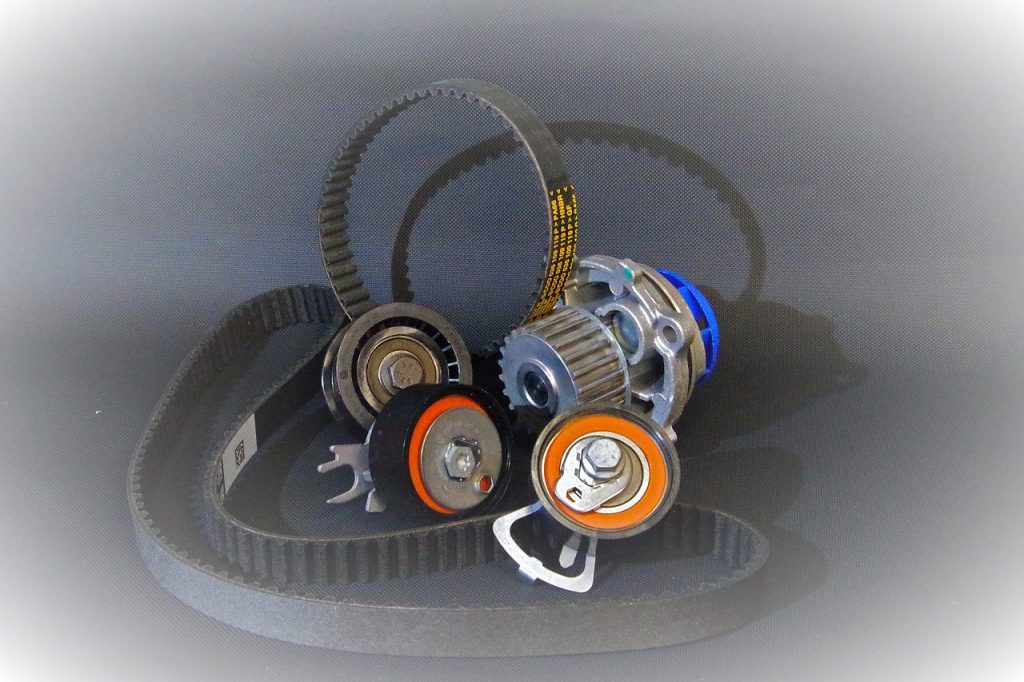Timing Is Critical: Timing Chains and Belts
Do you know what a timing belt or a timing chain is? And more importantly, do you know what happens if it fails? If you don’t, this is an article for you! You are going to learn something vital to maintaining your car.
If none of this sounds new, you can skip to the second half of this article for some practical information, like how to quickly check if a timing chain is still good.
Engine timing – valves & pistons
A typical car engine is based on the reciprocating motion of pistons inside cylinders. The combustion of air and fuel in the cylinders pushes the pistons down, which then drive the crankshaft. You can think of the crankshaft as the main shaft of the engine that all the pistons are connected to.
There is another very important shaft – the camshaft (at least one in each engine). The camshaft has a series of cam lobes that push on the engine valves to open them at the right times. The valves control the flow of fresh air into the cylinders and the flow of exhaust gases out. For the engine to function properly, the movement of the valves and pistons must be synchronized.
Interference & non-interference engines
The piston and valve synchronization is not only important for the operation of the engine but also its integrity. If the valve timing goes out of sync, the pistons may hit the valves. This is because, at certain times during the engine operation, they all occupy the same space.
Engines that are designed in such a way are called interference engines because the valves and pistons can interfere with each other. You can replace the word “interfere” with “smash” if you like.
The interference engine design is a byproduct or high compression ratios in modern engines and the use of more than two valves per cylinder, which requires the combustion chamber to have a certain shape. The majority of modern engines are interference designs.
By contrast, a non-interference engine will simply freewheel to a stop when the timing belt or chain breaks. That’s because the clearance between the valves and pistons is large enough that they cannot collide.
A good example of a non-interference engine is the Fiat’s 8-valve “FIRE” used in all the generations of the Fiat Panda since 1986. The little FIRE engine remained a non-interference design until 2010 when variable valve timing was added and compression increased to meet Euro 5 emission standards.
Have a look at the video below. Pay attention to how closely the pistons and valves work to each other in an interference engine.
Okay, let’s get to the point. To maintain the correct timing between the valves and the pistons, the crankshaft and the camshaft(s) must rotate in sync. The camshaft is driven off the crankshaft. In the vast majority of modern car engines, this is achieved by using a timing belt or a timing chain.
Sometimes, gears are used too, but that’s quite rare. The timing belts and chains are the two most common solutions so we’ll focus on them.
Timing chains
I’m sure you remember what a bicycle chain looks like. It’s called a roller chain and it’s one of the two types of timing chains commonly used in car engines. The other type is called a silent chain, just like the one in the video above.
Regardless of the chain type, one of the two main differences between a timing chain and a timing belt is that the chain lives inside the engine, where it is lubricated by engine oil. On the contrary, a timing belt runs dry. The timing belt is usually hidden under a plastic cover.
The other major difference is the lifespan. A well-designed timing chain should last the “lifetime” of the engine, while a timing belt will typically need replacing every 60,000 – 100,000 miles. We’ll get back to the definition of “lifetime” later.
Apart from the chain, the other key components that support the timing chain are the chain guides and the chain tensioner. The chain guides lead the chain through the engine and prevent it from slapping against the chain casing, while the chain tensioner applies tension to the chain to prevent it from skipping teeth.
The tensioner uses the pressure of the engine oil to do this. That’s why it’s called a hydraulic tensioner.
Here’s what it all looks like:
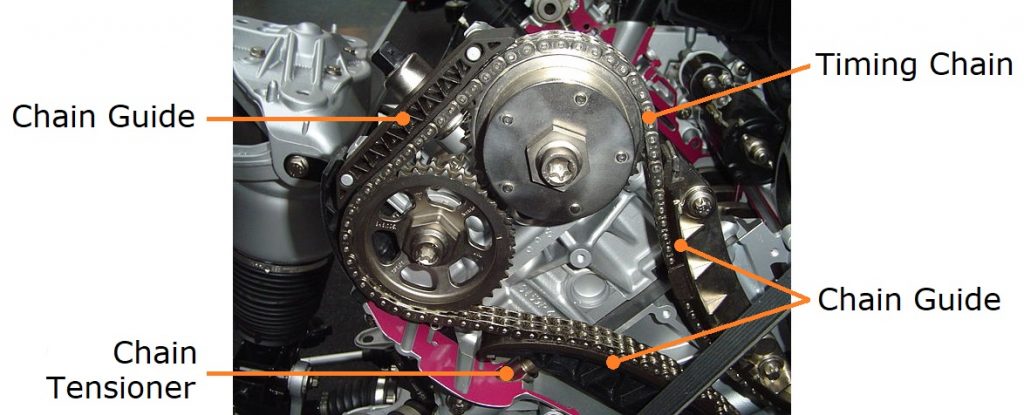
Photo by kolossos (modified); Source: Wikipedia; License: CC BY-SA 3.0
Timing belts
The timing belt, also called the cambelt, is a toothed belt that works together with matching toothed pulleys. Because of the teeth, it cannot slip. Therefore, it can be used to maintain the timing between the crankshaft and the camshaft(s).
The timing belt must be kept in constant tension by the timing belt tensioner. This is to prevent it from jumping teeth on the pulleys, which would mess up the engine timing. In a typical car engine, there is also one or two idler pulleys that guide the timing belt.
In the majority of cars with a timing belt, the water pump is also driven by the timing belt. The water pump is not an essential part of the timing system. Therefore, in some engines, it is driven by the auxiliary belt.
Here’s what a typical timing belt setup looks like in a 4-cylinder engine with the water pump driven by the cambelt:
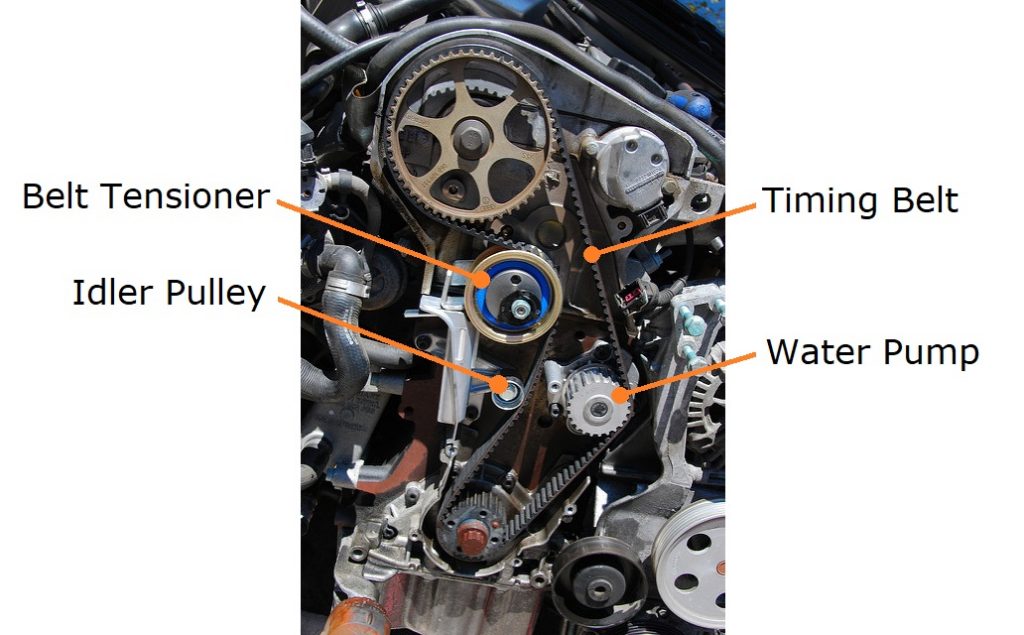
Photo by Nick Nguyen (modified); Source: flickr; License: CC BY-SA 2.0
When worlds collide
So what really happens when the valve timing goes out of sync in an interference engine?
The best case scenario is an engine that runs poorly or doesn’t run at all if the cambelt/chain just skipped a tooth. The worst case scenario is a badly damaged engine if too many teeth are skipped or the cambelt/chain breaks. The damage is caused by the valves colliding with the pistons.
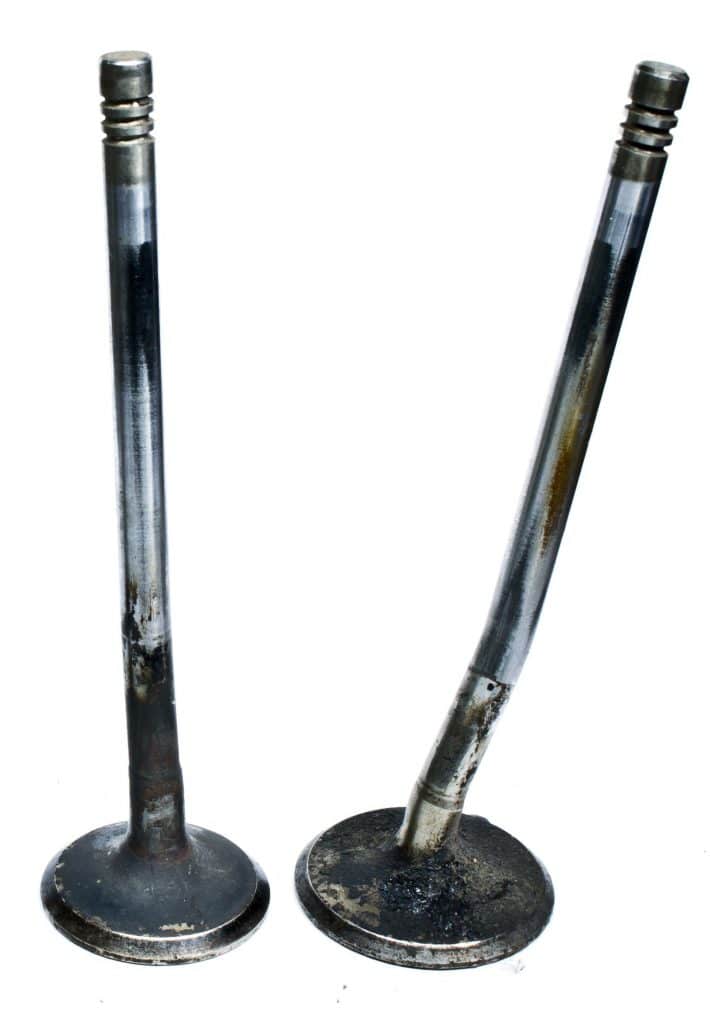
By the way, the one on the left is also bent, just not as much.
If you’re lucky, you may get away with some bent valves and no other damage. New valves are not expensive but the amount of work required to fit them is quite extensive. The air intake, the injection system, the exhaust manifold, the timing cambelt/chain, and the cylinder head – all these components need to be removed to get to the valves.
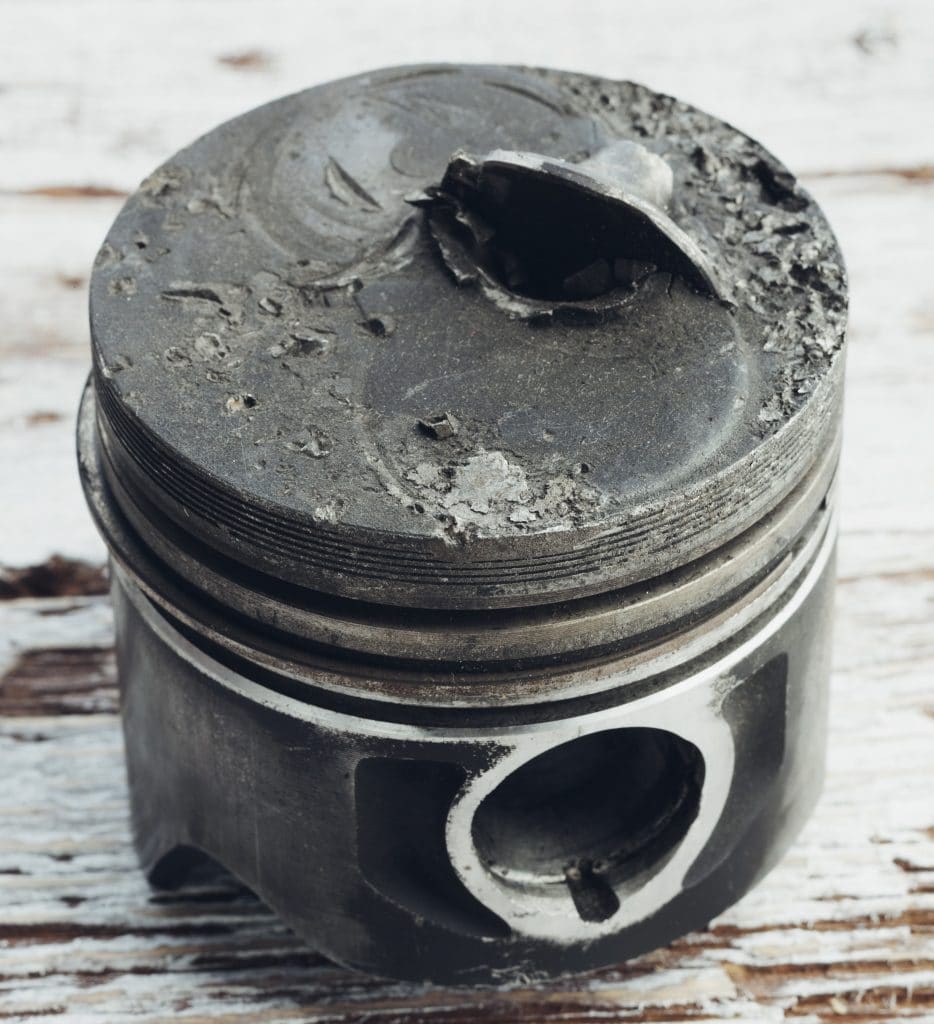
If you’re not so lucky, a valve may punch a hole in a piston and even the crankshaft bearings may get damaged. Either way, fixing an engine wrecked by a failed timing belt or chain is either expensive or very expensive.
Timing belt maintenance
All cars fitted with a timing belt have a specified belt replacement interval. You will find it in the car owner’s manual. The service intervals vary, but typically it’s between 50,000 and 100,000 miles. The cambelt is made of rubber so it degrades over time. Even if you don’t drive much, you will still need to replace it every 5 – 10 years.
Whenever the timing belt is due for renewal, it should be replaced along with the tensioner, idler pulleys and the water pump. All components are equally important.
For example, a water pump with worn out bearings can seize and snap the timing belt. It’s not worth trying to save £25 by not replacing a pulley or the water pump. A water pump that fails can take out the timing belt and crash your engine.
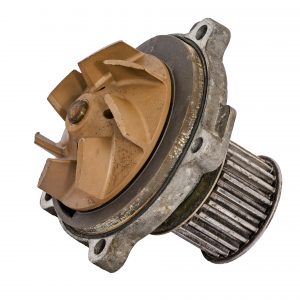
If you are going to spend time or money disassembling everything in the way to the cambelt, you should do the job properly and renew all the components. When you pay someone to do it, please make sure all the parts are replaced, not just the belt.
If you are going to buy a used car with a timing belt, find out if the previous owner replaced the timing belt as specified in the service manual. If it’s not due yet, it will likely be up to you to get it done in the future.
However, it’s a bad sign if the cambelt replacement is overdue or the seller doesn’t know whether it was replaced or not. What else has been neglected?. If you don’t know when the cambelt was last replaced, replacing it should be the first thing to do if you decide to buy such a car.
Timing belt replacement cost
The usual cost of a timing belt replacement, along with the tensioner, pulleys and the water pump is £300 – £500 in an independent car repair shop. This is a typical timing belt replacement cost for a 4-cylinder engine.
If it’s a V6 or a V8, it usually costs more. You may have to pay £400 – £800 for a timing belt replacement in these larger engines. This is because there are more parts to replace and it’s often more difficult to access the timing belt because of the larger engine.
Keep in mind that these are independent garage prices. Dealerships can charge even up to 50% more. However, sometimes you can get a good deal if you have a car with a popular engine.
I recommend contacting your local dealership to make sure the interval specified in your car owner’s manual is still valid. Sometimes, the service recommendations change. There have been instances where a car manufacturer cut the replacement interval in half because of an over-optimistic initial recommendation.
Symptoms of a bad timing belt
Unfortunately, a bad timing belt rarely shows any symptoms of a problem until it’s too late. If the belt skips a tooth, you would notice it because the engine would run poorly or not run at all.
Obviously, you don’t ever want the timing belt to reach a point where it skips teeth or breaks, as it can seriously damage the engine.
There may be no obvious symptoms before timing belt failure, however, there are a few warning signs to look out for:
-
clicking noises coming from the timing belt cover
-
squeaking or whirring noises – this may be a bad bearing in the water pump or one of the pulleys
-
oil coming from the timing belt cover – this may be a leaking camshaft seal. Oil will ruin the timing belt, so it’s important to fix this quickly (and replace the timing belt).
If you’re worried, you can visually inspect the timing belt. Removing the timing belt cover (or at least a part of it) is usually not that difficult.
Timing chain maintenance
Generally, when a timing chain is used, the intention is for it to last the “lifetime” of the engine. “Lifetime” can be very roughly defined as 200,000 miles.
Timing chains are meant to be a lot more durable than timing belts, and for this reason, the manufacturers don’t usually specify a replacement interval (please check your car owner’s manual).
Typically, you are only meant to replace the timing chain or other chain drive components when there is a problem. Most problems are usually related to a loose chain. It’s common to say that a chain has “stretched“.
A stretched chain is at risk of skipping teeth and altering the timing of the engine (with bad or catastrophic consequences). Typically, loose timing chains become noisy when they flop around inside the casing.
Just for clarification, chains don’t really stretch – it’s the wear on the pins that makes the chain longer. Additionally, as the timing gears wear, their diameter is reduced, which adds to the slack in the system. Also, the tensioner may be failing to apply enough tension to the chain.
You are probably wondering if chains can really last for 200,000 miles.
It depends.
There have been cases of cars that routinely managed to do a lot more than 200,000 miles on their original timing chains. Everything comes down to correct maintenance and the design of the engine:
-
The timing chain in an inline engine should last longer than in a V-type engine simply because it is shorter. Therefore, it’s less susceptible to stretching (cumulative wear of the chain pins). Also, the fewer gears a chain has to go over, the longer it will last (less movement of the pins and less wear on the rollers).
-
Insufficient lubrication can shorten the chain lifespan dramatically. That’s why it’s important to use good quality engine oil and replace it regularly.
-
A double row roller chain is more durable than a single row roller chain.
-
The weakest component defines the life of the system. What I’m trying to say is that apart from the chain, the chain tensioner, sprockets and chain guides must last long enough. Often, it’s the chain tensioner that gives up first. Also, there have been many cases of plastic chain guides failing before the chain or the tensioner.
Some of the 1980s Mercedes-Benz engines are great examples when it comes to long-lasting timing chains. Some of these cars managed to do over 300,000 miles on their original chains and that was using inferior engine oils when compared to what is available today.
Don’t try this at home though. When you get near 200,000 miles, you should consider replacing the timing chain, chain tensioner and chain guides in any car. They are moving parts, and they will eventually wear out even in the most robust engines.
On the other end of the spectrum, there are engines that typically fall short of reaching our definition of “lifetime”. This is usually caused by some kind of design flaw, for example, insufficient oil supply to the timing chain, weak plastic chain guides or simply an undersized timing chain. Keep in mind that poor maintenance will also reduce the lifespan of the system.
I recommend doing some research before buying a used car with a timing chain because your peace of mind may be interrupted by the timing chain rattle of doom the first time you start your newly-acquired car in the morning. There is a basic check you can do before buying a car with a timing chain – more will be explained below.
Timing chain replacement cost
Timing chain replacement is more expensive than renewing a timing belt. The parts are more expensive and it’s more difficult to access the timing chain.
Timing chain replacement typically costs £400 – £2000 in an independent garage.
Simple 4-cylinder engines with a single timing chain fall in the lower end of the spectrum. V6 and V8 engines with more than one timing chain fall in the upper end of the spectrum.
As you can see, the price range is quite wide. That’s because some larger engines may have even four timing chains (and four tensioners). Additionally, some cars have the timing chain at the back of the engine. This is because some manufacturers assume that the chain will not need replacing (nonsense!).
The price range can be even wider when you take the car to a dealership for timing chain replacement. Dealership prices fall in the range of £500 – £4000.
Having to replace a timing chain may not be that big of a deal if you are planning to keep the car for a few years (depending on the cost!). It’ll give you peace of mind for a long time.
However, a manufacturer of an engine with a timing chain system that wears out before reaching 100,000 miles deserves the middle finger, in my humble opinion. That’s because timing chains can last twice as long when the design is not compromised by cost-cutting or design flaws.
I can’t see the point of making a car with a metal timing chain that lasts shorter than a rubber timing belt…
Okay, enough ranting. Let’s get back on track.
Symptoms of a bad timing chain
Usually, the first symptom of a timing chain problem is chain noise (rattle) for the first couple seconds after a cold start. If you are planning to buy a car with a timing chain (or you already own one), you should establish the condition of the timing system.
A simple test you can do is to listen for any chain noise when the engine is started. This needs to be a cold start after the car has stood still for a couple hours (ideally overnight). It’s because you want to listen to the engine when the oil hasn’t reached the chain tensioner yet.
After a long standstill, the oil drains to the sump and it takes a couple seconds for the oil pump to distribute it all over the engine.
A loose chain will make a rattling noise before the tensioner takes out the slack. The more slack in the system, the longer the noise will last and the louder it will be. If the timing chain noise is persistent, it means the chain drive is on its last leg.
Open the bonnet, stand near the engine and ask someone to start the car for you. If you can hear a rattle that disappears after a couple seconds, it’s most likely a chain that has stretched too much or a failing chain tensioner. It’s a typical symptom of a loose chain. I recommend that you don’t buy such a car unless you are planning to service the timing chain as part of preventative maintenance.
There are two types of tensioners used in car engines – a ratcheting and a non-ratcheting design. The ratcheting tensioner has a mechanism that prevents the tensioner from withdrawing when there is no engine oil pressure, for example, during the first couple seconds after the engine is started. The non-ratcheting tensioner doesn’t have this mechanism and relies on a spring to maintain some chain tension before oil pressure builds up.
In my opinion, it is acceptable for an engine with a non-ratcheting tensioner to have a mild rattle for around a second after a cold start. As for an engine with a ratcheting tensioner, try to find a car that doesn’t rattle at all.
Treat this as a guideline, not a stiff rule. There is no standard for how long the timing chain noise should last and the best thing to do is to compare cars with the same engine models to see if one sounds better than the other. Ideally, when the timing chain system is in good condition (and not poorly designed), there should be no noise at all, regardless of the tensioner design.
Marbles in a can (timing chain noise)
Here’s a collection of videos showing what timing chain noise sounds like:
-
Rattly Fiat 1.3 Multijet – If your car sounds like this, I recommend getting it serviced immediately. The chain rattle is very noticeable even though it’s a loud diesel engine.
-
Less rattly Fiat 1.3 Multijet – Same engine as above but less noisy. Still, a rattle like this is not a good sign and likely qualifies for a service visit.
-
Very rattly Volkswagen 1.6 FSI – This is exactly what you don’t want to hear. This could be a loose timing chain or a worn-out cam adjuster (cars with VVT only). The noise is a bad sign regardless.
-
Too rattly Volkswagen 2.0 TSI – The noise lasts only for about 2 seconds but that’s not good enough because this car has a ratcheting tensioner.
-
Audi 4.2, before and after – This was only 2.5 seconds of chain rattle but the service cost 5800$ according to the owner of the video. It cost this much most likely because in this car, there are four timing chains, four tensioners and all of it is at the back of the engine.
Apart from the rattling noises, other potential symptoms of a problem with the timing chain include reduced engine performance, a “Check engine” light and error codes related to camshaft timing stored in the car’s computer.
If you’re worried or unsure about the condition of the timing chain in your car, take it to a professional. A more accurate method of checking the chain stretch is to use the engine’s timing marks. The chain stretch is usually measured in degrees (timing shift). A visual inspection of the chain guides or the tensioner may reveal something too.
Camshaft adjuster rattle (VVT cars only)
Cars with variable valve timing (VVT) have special sprockets or pulleys that have a built-in mechanism to adjust the timing of the camshafts using oil pressure. These sprockets are called camshaft adjusters or cam phasers.
The VVT mechanism locks up when there is no oil pressure, for example, during a cold start after a long standstill. The camshaft timing is supposed to be fixed until oil pressure builds up and the VVT can start adjusting the timing.
It is designed this way because the cam adjusters rely on oil pressure to operate. If they don’t lock up properly, the timing goes all over the place until oil pressure builds up.
A side effect of cam adjusters that remain unlocked (because they are broken) is a rattling sound when there is no oil pressure yet.
So, the symptom of a failing VVT mechanism is a rattling, diesel-like noise after a cold start. Ideally, there should be none, but after a long standstill, I would say that a gentle rattle for a second or two is still okay in older cars. Any longer than that and the camshaft adjusters are on their way out. If the rattling is persistent, they are definitely broken.
Click here to hear the VVT rattle. Rattling camshaft phasers aren’t as dangerous as a rattling timing chain, so a brief rattle after a cold start isn’t something to worry about in older cars. If you are worried, it’s best to compare two cars with the same engine and listen if there’s a difference.
However, a persistent noise (like in the video linked above) or one that lasts a few seconds or more means that there is definitely a problem.
Conclusions
The key points to take away from all this are:
-
The timing belts or timing chains, along with the supporting components, are one of the most important parts in the engine. Their failure often results in serious engine damage in interference engines (most modern engines).
-
Always keep track of when the timing belt needs to be replaced in your car. When the time comes, replace all the critical components, not just the belt. If you are going to buy a used car with a timing belt, find out if the previous owner replaced the timing belt and other key parts on time.
-
The typical timing belt lifespan in between 50,000 and 100,000 miles.
-
Timing chain vs Timing belt: timing chains last longer than belts, but they are more expensive to replace when they wear out. A well-designed timing chain system can last a very long time but not forever.
-
When you get near 200,000 miles, you should consider replacing the timing chain, chain tensioner and chain guides. If the timing system is showing symptoms of wear, it may need to serviced earlier and in some cars, a lot earlier. Do some research before buying a used car with a timing chain – some models are unlikely to get to 200,000 miles without chain replacement.
-
If you’re looking to buy a used car, find out if it has a timing belt or a chain. You can find this information in the Car Directory. If the car has a timing chain, look out for any chain noise during a cold start. Timing chain noise is a common symptom of chain stretch or a failing tensioner.
-
One last thing – worn out cam adjusters in cars with variable valve timing can also make a rattling noise during a cold start. They are cheaper to replace than a full timing chain kit but rattling noises are a bad sign nonetheless. Better find a car that purrs, not rattles.
If you found this article useful, please share it with your friends!
May the valves and pistons in your car’s engine never meet (it’s a toxic relationship).

